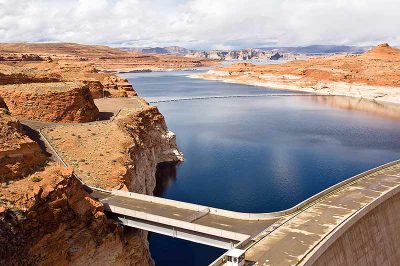
Nevada legislators want to drain Lake Powell

Wikimedia Commons Lake Powell, Ariz.
WINDOW ROCK

Wikimedia Commons
Lake Powell, Ariz.
If some Nevada lawmakers had had it their way, Lake Powell would have been drained and Glen Canyon Dam destroyed.
A committee of the Nevada state legislature passed a resolution urging federal authorities to drain Lake Powell and destroy Glen Canyon Dam, but the resolution died when the full senate failed to consider it by deadline.
During a Nevada Senate Committee on Natural Resources meeting held on May 17 in Carson City, Nevada, the idea to drain Lake Powell and destroy Glen Canyon Dam was introduced under Assembly Joint Resolution, or AJR, 4.
Under AJR 4, the NSC requested the National Research Council of the National Academy of Sciences conduct an independent scientific and economic analysis of the current management practices of the Colorado River. Committee members wanted to find out how these practices impacted water security, flood protection, and biodiversity recovery.
The AJR, co-sponsored by Assistant Majority Whip Assemblywoman Heidi Swank (D) and Nevada State Senator Tick Segerblom (D), said the Colorado River provided water to seven states, 20 Indian Tribes, including the Navajo Nation, and Mexico, and was critical to the economies, people, natural resources if these jurisdictions.
Swank and Segerblom said in their joint resolution climate change and overconsumption threatened the Colorado River.
“Numerous independent scientists have warned that the current management practices of the Colorado River may be placing those who depend on (it) at risk,” they said in their February 13 joint resolution. “The water management infrastructure of the Colorado River is outdated and based on an invalid assumption which causes unintended impacts and risks.”
The joint resolution went on to say that Glen Canyon Dam posed a safety risk to the residents of Nevada, losing billions of gallons of water stored in Lake Powell each year due to evaporation and leakage from the reservoir. The dam also disrupted natural sediment transport and impacted the cultural heritage and religious practices of indigenous people, they said.
“The National Research Council of the National Academy of Sciences is uniquely qualified to conduct an independent review and analysis of the current management practices of the Colorado River,” the joint resolution read, noting the sponsors wanted the academy to study “the impact of these practices on water security, flood protection and biodiversity recovery, and alternative management strategies to overcome any impacts, including altering and augmenting infrastructure, specifically draining Lake Powell and decommissioning and destroying Glen Canyon Dam on the Colorado River.”
According to the “Visit lake Powell” website, construction on the dam began in 1956 and was completed in 1963, as part of the U.S. Government’s authorization to the Bureau of Reclamation to build the dam on the Colorado River. The purpose of the 700-foot high dam was for water storage and hydroelectric power generation for the southwestern states.
Additionally, the website said more than three million people visited the lake annually.
To read the full article, pick up your copy of the Navajo Times at your nearest newsstand Thursday mornings!
Are you a digital subscriber? Read the most recent three weeks of stories by logging in to your online account.







 Highway 264,
Highway 264, I-40, WB @ Winslow
I-40, WB @ Winslow